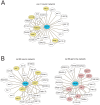Global prediction of tissue-specific gene expression and context-dependent gene networks in Caenorhabditis elegans
- PMID: 19543383
- PMCID: PMC2692103
- DOI: 10.1371/journal.pcbi.1000417
Global prediction of tissue-specific gene expression and context-dependent gene networks in Caenorhabditis elegans
Abstract
Tissue-specific gene expression plays a fundamental role in metazoan biology and is an important aspect of many complex diseases. Nevertheless, an organism-wide map of tissue-specific expression remains elusive due to difficulty in obtaining these data experimentally. Here, we leveraged existing whole-animal Caenorhabditis elegans microarray data representing diverse conditions and developmental stages to generate accurate predictions of tissue-specific gene expression and experimentally validated these predictions. These patterns of tissue-specific expression are more accurate than existing high-throughput experimental studies for nearly all tissues; they also complement existing experiments by addressing tissue-specific expression present at particular developmental stages and in small tissues. We used these predictions to address several experimentally challenging questions, including the identification of tissue-specific transcriptional motifs and the discovery of potential miRNA regulation specific to particular tissues. We also investigate the role of tissue context in gene function through tissue-specific functional interaction networks. To our knowledge, this is the first study producing high-accuracy predictions of tissue-specific expression and interactions for a metazoan organism based on whole-animal data.
Conflict of interest statement
The authors have declared that no competing interests exist.
Figures






References
-
- Fowlkes CC, Hendriks CL, Keranen SV, Weber GH, Rubel O, et al. A quantitative spatiotemporal atlas of gene expression in the Drosophila blastoderm. Cell. 2008;133:364–374. - PubMed
-
- Lein ES, Hawrylycz MJ, Ao N, Ayres M, Bensinger A, et al. Genome-wide atlas of gene expression in the adult mouse brain. Nature. 2007;445:168–176. - PubMed
-
- Bamps S, Hope IA. Large-scale gene expression pattern analysis, in situ, in Caenorhabditis elegans. Brief Funct Genomic Proteomic. 2008;7:175–183. - PubMed
Publication types
MeSH terms
Substances
Grants and funding
LinkOut - more resources
Full Text Sources

